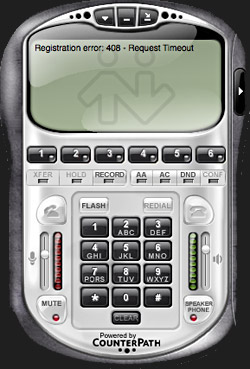A Software Nightmare

Many of you may have heard of X-Lite, a very common and arguably the most full-featured softphone around. This is a free application that supports SIP telephony and essentially allows you to register to your SIP provider and place calls to other people over your internet connection.
X-Lite is developed by CounterPath Corp., that also develops commercial high-end softphone applications, namely eyeBeam, a more powerful SIP phone with optional support for video conferencing and Bria, a recent addition that does away with the traditional keypad based interface and adopts a contact-list interface ala most Instant Messaging applications.
My first encounter with X-Lite was in 2003. I installed it on my Mac boxes and was very quickly dismayed by its horrible performance, kludgy interface and complete disregard to the Apple UI Guidelines; the application has its own skinned UI, evidently designed by people with minimal interest in usability, but was — and remains — the most full featured SIP softphone on the market. It was also free.
Needless to say, I quickly got rid of X-Lite and started using Skype, an up and coming project that provided a much better client on the Mac than the kludge that was X-Lite.
Four years later and I’ve banished Skype from my machines, for a number of reasons, one of which was — ironically — its performance, both in terms of resource use and call quality.
Since 2003 the SIP ecosystem has developed into a much more substantial entity. There are numerous providers, many affordable and high quality hardware choices, better call packages, but still very few quality SIP softphones for any platform. X-Lite has also improved over the years, with much improved performance, and better response, but it retained the — marginally improved — moderately acceptable skin UI.
Since late October, when Mac OS X Leopard was released, X-Lite stopped working on the Mac. I generally don’t really care, as I do most of my VoIP calling from a hardware Linksys phone, but last week I was in London for a few days and needed to use a softphone to place and answer calls on my various SIP accounts. CounterPath stated, on its forum, that it was Leopard’s fault that X-Lite doesn’t work on Leopard and that a new version of X-Lite would appear in early December. The date was then pushed back to the end of the year and again to Q1 2008. In the meantime, they released a ‘fixed’ version of eyeBeam for Leopard.
Being in need of a softphone and with very few working options available to me — I tried several free alternatives, including XMeeting and SJPhone; none of these really cut it — I bought eyeBeam hoping that it’d work fine. This was a $40 purchase, not exactly a small amount of money for an application of this kind.
The results were disappointing. On one hand it performed relatively well when exposed directly to the net, i.e. when it was not behind a NAT router. Its call quality was excellent, and I managed to call several PSTN phone numbers in Athens using my TerraSIP account — which at this moment trials free calls to a number of destinations — without any problems. On the other hand, it failed miserably to register to my SIP providers when behind a NAT, despite the fact that I had configured it to use a STUN server. The application took a long time ‘Discovering [the] Network’ before attempting to Register and finally giving out a 408 (Request Timeout) error.
As if its failure to function behind a NAT router was not enough, it quickly became clear to me that eyeBeam is one of those applications that are written for one platform, in this case Windows, and are ported to another (Mac) without any consideration for its characteristics, features and conventions. Besides the frustrating UI, eyeBeam has two volume sliders, one for audio input and one for audio output. While every single Mac OS X application I’ve used essentially controls its own — application-specific — volume level, moving the eyeBeam sliders modifies the system volume level. It also resets the balance of the speakers, and changes the volume when it receives an incoming call to a deafening level I’m sure many will not appreciate, especially if on ear/headphones.
While older operating environments, such as earlier versions of Windows and several sound subsystems for linux, effectively required an application to take control of the system volume level as the concept of per-application volume was nonexistent, on Mac OS X this is unbelievably frustrating and completely unacceptable. From CounterPath’s forum, this seems to be a known problem for more than 2 years, at which time the company’s response has been practically non-existent, besides the odd comment stating that ‘engineering is aware of the problem’.
Upon my return to Hellas, I tried using eyeBeam from home. I’m still getting the dreadful ‘408’ error, even if, on the same network, X-Lite works perfectly on Windows or Mac OS X Tiger, as do all other SIP clients I’ve tried. The application is also one of the most unstable I’ve seen on the Mac for years. Clearly this build is not even alpha quality. Judging from its response on the support forum, CounterPath seems not to particularly care about its paying customers complaining about the fact that its application is practically unusable. If you’re using a Mac and are on the market for a SIP softphone do not, under any circumstances, buy eyeBeam. Until CounterPath gets serious about fixing all that’s wrong with this application, that is. And there’s really so much there to fix before eyeBeam is even close to being useful.
On the screenshot of the application above you can see some jagged edges on the left and right of the application. Yep, those are part of the ‘skin’, not artifacts introduced by me. Sigh.
